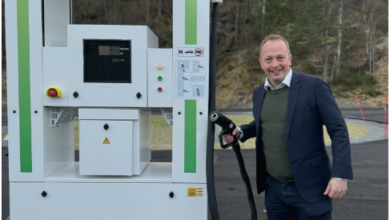AlphaStruxure, Montgomery County, MD announced an integrated microgrid infrastructure project featuring on-site green hydrogen production

AlphaStruxure, a leader in Energy as a Service (EaaS) microgrid solutions, and Montgomery County, Maryland (County), announced an integrated microgrid infrastructure project, featuring electric bus charging and on-site green hydrogen production powered by solar and battery energy storage, for Montgomery County, Maryland’s Equipment Maintenance and Transit Operation Center (EMTOC).
This is one of three transit bus depots in Ride-On Montgomery’s network and the fifth largest County owned energy consumer. By 2035, the site is projected to accommodate over 200 mixed-fleet vehicles. This project is expected to begin construction in Q4 2023 and be in operation by Q1 2025. The announcement of this innovative project follows the launch of the Brookville Smart Energy Bus Depot, the County’s first fully constructed microgrid-powered bus depot, in October of last year, which was also led by AlphaStruxure.
Comprising 5 MWDC of rooftop and canopy solar generation, 2 MW/7.35 MWh battery energy storage, existing backup generation, and up to 4.5 MW of charging capacity, the EMTOC microgrid will provide sustainable, resilient power to a mixed fleet of battery electric and fuel cell electric buses (FCEB) as well as EMTOC’s five existing buildings.
The microgrid will be interconnected to the Pepco utility and is engineered to operate in island mode indefinitely, ensuring uninterrupted service for the County’s constituents during extended grid or power outages and emergency situations. The microgrid’s solar generation will also provide power for the on-site production of green hydrogen, a resilient power source to FCEBs that have a greater range over battery electric buses, necessary for longer bus routes. A FCEB is a zero-emissions vehicle, powered by hydrogen and oxygen, and emits only water. By embracing hydrogen fuel technology, Montgomery County can further enhance its equitable Bus Rapid Transit (BRT) network and create new career and training opportunities for underserved communities.
By fueling the County’s initial 13 FCEBs with green hydrogen produced by the microgrid’s solar, this solution not only advances the County’s goal to achieve net zero carbon emissions by 2035 but also reduces their Scope 1 and 2 emissions by 4,000 metric tons of CO2 per year, equivalent to approximately 780 homes’ electricity use for one year.
The microgrid is delivered without capital expenditures to the County through an EaaS contract, a long-term agreement ensuring predictable operating expenses and guaranteed performance without upfront capital expenditures.
“Once built, the EMTOC microgrid will be the gold standard for resilient, sustainable public transit. This project also further establishes Montgomery County, MD as the nation’s leading municipality when it comes to embracing the transit infrastructure of tomorrow,” said Juan Macias. “We are thrilled to be the County’s long-term partner on holistic infrastructure that delivers improved, cleaner services to constituents. Our Energy as a Service approach enables us to deliver an integrated bus fleet solution that is bolstered by a resilient energy supply, all without imposing any upfront costs or financial, construction, or operating risks on the County. We are excited to be part of this innovative and transformative initiative that will shape the future of public transit for years to come.”
“Through our long-term partnership with AlphaStruxure, we’re excited to launch one of the most advanced bus depots in the country,” said Marc Elrich. “This project represents a significant milestone in our ongoing efforts to achieve our ambitious climate action, which aims to reduce all carbon emissions by 2035 while substantially enhancing the resilience of our transit services. Of particular excitement is the integration of green hydrogen production, powered by the microgrid, highlighting our commitment to pioneering cutting-edge renewable solutions and leading by example when it comes to sustainable, resilient transportation.”
